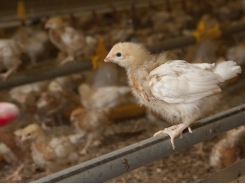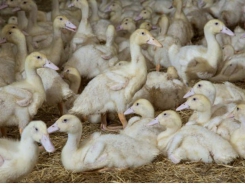Copper type may influence vitamin stability in feed

Use of trace minerals in feed may support the stability of added vitamins, allowing for more economical feeds.
We caught up with Scott Fry, director of technical sales support, Micronutrients during IPPE to hear more about the research the company has been doing to explore the interaction of different types of copper sources with added, fat-soluble vitamins in feed.
The Indianapolis-based trace mineral feed additive producer is a Nutreco Company.
“Our research is focused on trace mineral research, our IntelliBond brand, versus sulfates in particular,” Fry said. “These data are focused outside the animal in feed looking at dynamic stability.”
The project explored the chemistry involved in the use of feed additives for broiler diets when different forms of copper are added, he said.
The current price spike in the vitamin market for animal feed makes the research relevant for producers, he said. “We’re dealing with a spike right now in regards to cost, so stability is a big part of the value proposition as it relates to IntelliBond in the feed.”
Copper type and vitamins
In feed there can be different elements that are susceptible to oxidation, said Fry. These ingredients include different vitamins like A and E.
Copper can act as a pro-oxidant when it is unbound, he said. “It all really goes back to the chemistry of the product – if you look at copper sulfate you have an ionic bond that is very weak and when exposed to water it becomes free, and you have free copper,” he added.
“Free copper is a bad thing as it can cause damage – vitamin E would be one, vitamins, in general, would be something it would interact within the feed and cause a detrimental effect on the stability of that ingredient,” he said.
However, the trace mineral mix includes a copper source that has a covalent bond, which may have a slower release and has a reduced solubility in water, he said. As feeds may include fats or be exposed to heat and humidity, the trace mineral product is less reactive.
In its research, the company looked at several levels of copper inclusion, said Fry.
“We’re looking at 250 parts per million (ppm) [copper], so something in the US,” he said. “Those are levels that can be used in swine and poultry in the US. And you think about your European markets where there are some restrictions on use, and there are other markets as well, we have data showing that at 10ppm we do have a difference there in vitamin stability between the two copper sources.”
The research also has a role to play currently as vitamin prices are high and feed producers or nutritionists may start evaluating the levels of vitamins added, he said. In some feeds, there may have been an overage in the amount of vitamin used and in other instances, there may be a trend to look at finishing stage feeds and consider the amount of vitamins included.
“Where our data set fits into this is, [when considering], ‘What else am I adding into the diet that could be affecting the stability of the diets?’” he said. “As an industry, we’ve started putting things all together and there can be some effects there that we’re not aware of, and this is a great example of copper source effecting vitamin stability.”
As concerns about vitamin level and feed economics continue, it may be time to evaluate other elements within the feed to determine exactly what is available to the animal, said Fry. “I’m paying x amount of money for vitamins, I put them in and I expect to get this, when in fact because of the copper source I’m using I’m not getting what I think I’m putting into it because of the stability,” he added.
Additionally, the company has done bioavailability studies looking at what is available to a broiler or a pig through the gastrointestinal tract, he said. It has found that the trace mineral use allows for a slower release of the copper over time, which reportedly allows for the copper to travel further down the GI tract.
Additional study details
In one study, samples taken of bird livers found higher levels of vitamin E when the non-copper sulfate feed additive was used at 150 or 450ppm compared to the same amounts of copper sulfate, the company reported. Vitamin E levels also were increased in the birds’ plasma.
In a related study looking at the use of vitamins A, D3 and E in diets supplemented either with the trace mineral mix or a copper sulfate additive in crumbled broiler starter feed, the company found that the use of steam during the crumbling process solubilized the copper sulfate additive and degraded the vitamins A and E.
Related news
Tools

Phối trộn thức ăn chăn nuôi

Pha dung dịch thủy canh

Định mức cho tôm ăn

Phối trộn phân bón NPK

Xác định tỷ lệ tôm sống

Chuyển đổi đơn vị phân bón

Xác định công suất sục khí

Chuyển đổi đơn vị tôm

Tính diện tích nhà kính

Tính thể tích ao



 Designing poultry nutrition programs to optimize profitability
Designing poultry nutrition programs to optimize profitability  Nutritional management of necrotic enteritis, coccidiosis
Nutritional management of necrotic enteritis, coccidiosis